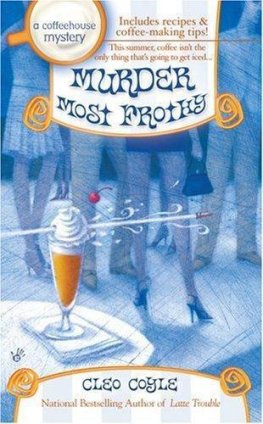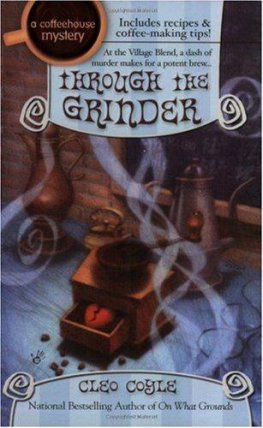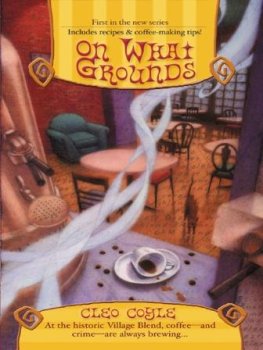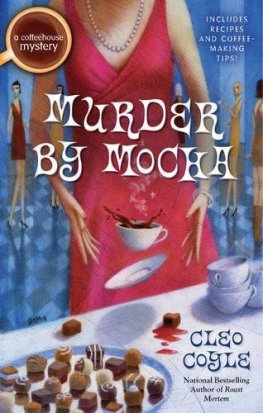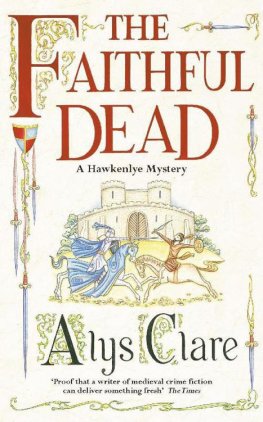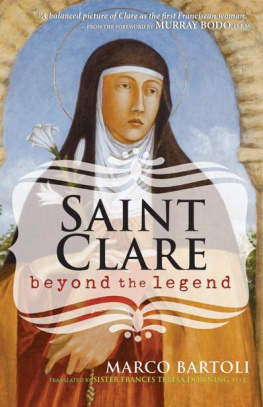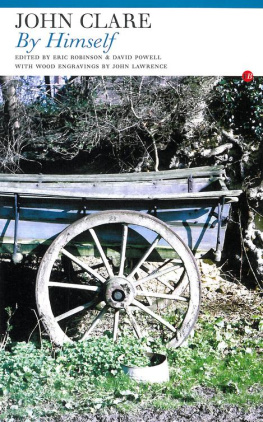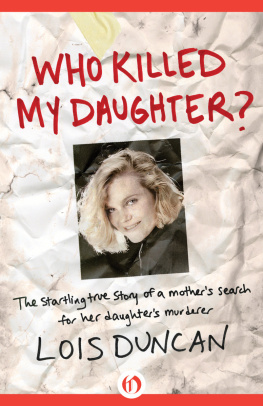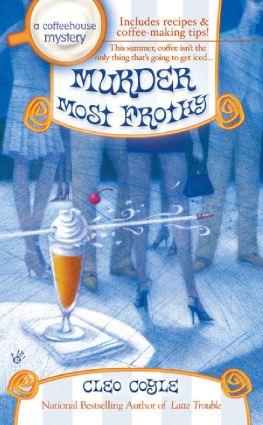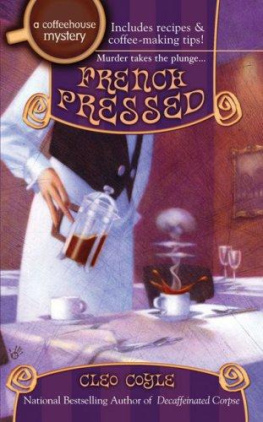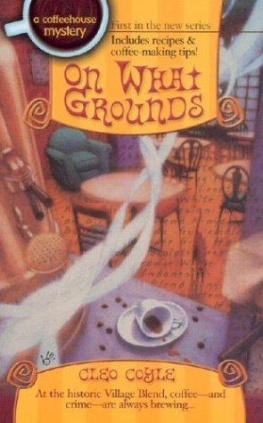Cleo Coyle
Murder Most Frothy
This book is dedicated with love to
Evelyn Cerasini
and Nana
A most frothy thanks to editors Martha Bushko and Katie Day, and literary agent John Talbot.
AMID the scrub grass of the high beach dune, gloved hands gripped seven pounds of bolt-action. Through the Remingtons scope, the shooter scanned the faces on the mansions expansive cedar deck.
The typical Hamptons crowd was here: Ivy League wives turned interior decorators, captains of industry turned serial cheaters, vapid heiresses turned wannabe celebrities. There were cold-blooded lawyers, eager-to-please newcomers, megalomaniacal executives, and tone-deaf pop singersall sipping frothy drinks and wearing designer casual with diamonds as big as planets, wristwatches as pricey as middle-class cars.
Women bared too much or too little, their laughter forced or nonexistent, their attention on each others clothing, on the faces in attendance, on the hosts choice of artifacts. Men acted too bored or too eager, their focus on networking, for business or pleasure, the mantra always the same: Close the deal, close the deal.
And, oh, the celebrities. They were here too, looking far less air-brushed than their cover shots on TV Guide and Entertainment Weekly. But those observations would only be whispered after the party or behind their backs during it.
At last, the shooter located the targethis short, stocky build was unmistakable, his untucked short-sleeved shirt an enormous pink flag. The trigger could have been pulled at that moment. Three rounds were loaded into the Remingtons magazine, three seven-millimeter bullets primed for their trip through twenty-four inches of steel and forty odd yards of night air. But the result would have been obvious.
The timing had to be right.
Guests came and went, clustering and dissipating like the tides. Music rolled over the mansions grounds, across the pool and manicured lawn, down the beach and onto the shoreline. Inside latex gloves, the shooters hands grew clammy. Behind the shooters feet, the foamy surf sounded restless, as if the ocean were lapping nearer with every passing minute, closing in with each incoming wave.
Finally, the target stepped away from the crowded deck and into the great room. The place was lit up like a whorehouse. With every shade up and shutter open, every bulb and chandelier blazing, guests could readily see the mansions splendorand the shooter could easily track the targets movements down the hallway and into the south wing, up the stairs and toward the master bedroom suite.
Rogue firecrackers had been exploding for some time, a bright bang here, a sharp crack there, just like any other Fourth of July evening, little detonations from god-knew-where. But those stray explosions were nothing. The nights most memorable fireworks were about to start.
Farther down the beach, the patriotic spectacle was finally launched. A succession of roman candles went up amid booms, blasts, and a pumped-up soundtrack. Rockets raced high over the water, bursting with an array of bright red light, trickling down like blood trails against the death-black sky.
Most guests were staring upward now, their blank faces dazzled by the show. The shooters focus remained far lower. For a few minutes, the target disappeared from view, then reappeared on the mansions second floor. He had moved to the bathroom window.
A shot rang out and then another. Both missed their target. A third round was fired. It traveled down the Remingtons barrel, through the thick window, and into the mans skull.
At the party below, guests were still gawking skyward. They had failed to notice the rifles discharge. Amid the fireworks, it was just another big bang.
Hours before I found the body, one of Detective Mike Quinns pithy comments came back to haunt me: You know, Clare, its a little-known principle of physics, a great deal of money can create a completely separate universe.
You were right, Mike, I whispered, taking in my surroundings.
I was standing on the bi-level oceanfront deck of Otium cum Dignitate, Leisure with Dignity, David Mintzers ten-million-dollar East Hampton mansion, where his annual July Fourth party was in full swing.
Floating candles bobbed in the Jacuzzi like dancing water fairies. Antique porcelain planters sweetened the sea air with rare orchids and night-blooming jasmine. Speakers, hidden in the topiary, accompanied the music of the nearby rolling surf with the majestic compositions of Gershwin and Copeland. And sterling-sliver serving trays overflowed with flutes of obscenely expensive champagne and freshly picked strawberries the size of lemons, dipped in the finest Belgian chocolate.
East Hampton, of course, was one of the most exclusive hamlets in the United States. It sat beside Amagansett, Wainscott, Sagaponack, Bridgehampton, Southampton, and a few other quaintly named seaside townships known collectively as the Hamptons, each with its own set of beaches, permits, and restrictive (some might say fascistically elitist) parking regulations.
East Hampton was also a prime example of my detective friends theory. For the very wealthy who summered here, from business moguls to movie stars, old money heirs to new money wannabes, the place was a trip back in time, where neon was outlawed, scenic rural landscapes were preserved, and genteel country estates were hidden from public view by towering stay out! hedgerows. (Or, as the local gentry referred to them, privets for breaking the ocean winds, because actually admitting your aversion for allowing the general public to even peek at your property might make you appear a total snob.)
The Hamptons, it seemed to me, were about a lot of things, but mostly they were about being one hundred miles away from the gritty threats and cheap kicks of New York City. Money had carved these people another dimension, an existence of safety and beauty and taste, free of the stench of fear and crime and tackiness.
The villages were located at the end of Long Islands South Fork, a picturesque strip of land filled with ponds, marshes, and hills. Bluewater bays stretched along its north side, the Atlantic ocean along its south.
There were hiking trails here and haute cuisine. Farm stands and a film festival. Bird sanctuaries and built-in pools. Nature preserves and tennis courts. You could find Jackson Pollacks original, unheated studio here, as well as Quelle Barn, Steven Spielbergs multi-million dollar East Hampton summer home, supposedly guarded by retired members of the MossadIsraels secret service.
Even the light was special in the Hamptons. Artists claimed it was the peculiar shape of the landscape, the slant of the suns rays as they bounced off the water. Whatever it was, they could find it nowhere else, which was one reason the area had become one of Americas most famous art colonies long before La-La Lands A-list had started driving up the real estate prices.
Hamptons colors actually appeared richer too (not just the people). One morning when I rose for an early swim, I found myself gaping at an azure ocean so identical to the sky above it that no horizon line presented itselfthe blue seemed to go on forever.
At the moment, on the other end of Long Island, the end without pristine white beaches, most of New York Citys residents were living on top of each other in cigar-box apartments, rundown rowhouses, and public housingall of them sweltering in the kind of relentless city heat that liquefied every ounce of energy before sucking it right out of you. Emergency sirens and shouting neighbors routinely punctured any hope of sustained tranquility, and sidewalk garbage, baking in the summer heat, fouled the air with the sort of fragrances that Calvin Klein wouldnt be bottling anytime soon.

